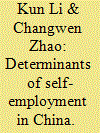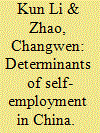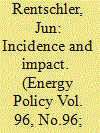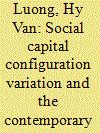|
|
|
Sort Order |
|
|
|
Items / Page
|
|
|
|
|
|
|
| Srl | Item |
| 1 |
ID:
105073


|
|
|
|
|
| Publication |
2011.
|
| Summary/Abstract |
This paper presents and tests a series of sources of regional variations in self-employment rate in China in the 2000s, and illustrates that the stage of economic development is a major explanation for the variations of self-employment rate across regions over the past decade. The negative relationship between the stage of economic development and self-employment rate identified in the paper indicates that China has entered the process of fast industrialization, and self-employment is playing a diminishing role in economic growth and employment. We also find a substitution effect between self-employment and private enterprises. While both are important components of China's private sector, private enterprises are becoming an increasingly important source of China's economic growth and employment. Furthermore, our findings also imply that when job opportunities are limited, self-employment in China is likely a forced choice of disadvantaged people who are not qualified for wage jobs.
|
|
|
|
|
|
|
|
|
|
|
|
|
|
|
|
| 2 |
ID:
105074


|
|
|
|
|
| Publication |
2011.
|
| Summary/Abstract |
This paper presents and tests a series of sources of regional variations in self-employment rate in China in the 2000s, and illustrates that the stage of economic development is a major explanation for the variations of self-employment rate across regions over the past decade. The negative relationship between the stage of economic development and self-employment rate identified in the paper indicates that China has entered the process of fast industrialization, and self-employment is playing a diminishing role in economic growth and employment. We also find a substitution effect between self-employment and private enterprises. While both are important components of China's private sector, private enterprises are becoming an increasingly important source of China's economic growth and employment. Furthermore, our findings also imply that when job opportunities are limited, self-employment in China is likely a forced choice of disadvantaged people who are not qualified for wage jobs.
|
|
|
|
|
|
|
|
|
|
|
|
|
|
|
|
| 3 |
ID:
149977


|
|
|
|
|
| Summary/Abstract |
Since fossil fuel subsidy reforms can induce significant distributional shifts and price shocks, effective compensation and social protection programs are crucial. Based on the statistical simulation model by Araar and Verme (2012), this study estimates the regional variability of direct welfare effects of removing fuel subsidies in Nigeria. Uncompensated subsidy removal is estimated to increase the national poverty rate by 3–4% on average. However, uniform cash compensation that appears effective at the national average, is found to fail to mitigate price shocks in 16 of 37 states – thus putting livelihoods (and public support for reforms) at risk. States that are estimated to incur the largest welfare shocks, coincide with hotspots of civil unrest following Nigeria's 2012 subsidy reform attempt. The study illustrates how regionally disaggregated compensation can be revenue neutral, and maintain or reduce pre-reform poverty rates in all states. Overall, it highlights the importance of understanding differences in vulnerability, and designing tailored social protection schemes which ensure public support for subsidy reforms.
|
|
|
|
|
|
|
|
|
|
|
|
|
|
|
|
| 4 |
ID:
152345


|
|
|
|
|
| Summary/Abstract |
Like other developing countries, China has been struggling with corruption. Judicial corruption, in particular, damages the rule of law and presents a market disruption as an outcome of a lack of commitment by the government regarding property rights. This article seeks to explain the variations in judicial corruption within China, and it develops a theory of city-level corruption of judges. The theory is tested by an empirical study with data from the World Bank corruption survey using a Bayesian spatial linear model. While wealth appears to diminish corruption, there is also a strong spatial relationship with regard to the level of judicial corruption in China, indicating that as some regions become less corrupt, surrounding areas also experience a diminution in corruption. Thus, through a process organic to the current regime, China could experience an increase in judicial trustworthiness.
|
|
|
|
|
|
|
|
|
|
|
|
|
|
|
|
| 5 |
ID:
159537


|
|
|
|
|
| Summary/Abstract |
This article examines the contemporary transformation of rural Vietnam in relation to market economy dynamics and regionally varying configurations of social capital. It is based on the author’s longitudinal and panel study of seven Vietnamese lowland communities (two in the north, two in the mid-central coast, and three in the southern Mekong Delta) over a decade in the twenty-first century. Living standards in the rural Vietnamese lowlands have increased significantly thanks mainly to migration, industrial production dispersal to smaller provinces, and the higher wages in rural communities that have resulted from reduced labour supply. However, per capita income has generally increased faster in communities in the northern delta and the central coast than in those of the Mekong Delta. This article suggests that the differences in social capital configuration between the northern Red River Delta and the central coast on the one hand, and in the southern Mekong Delta on the other, have contributed to the faster per capita income growth in the former.
|
|
|
|
|
|
|
|
|
|
|
|
|
|
|
|
|
|
|
|
|